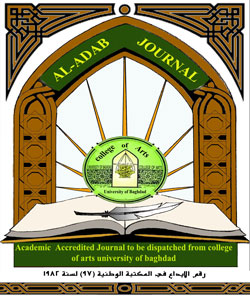الانفتاح علـــى الخبرة وعلاقتـه بحس الُدعابة لــدى طلبة كلية الآداب
DOI:
https://doi.org/10.31973/aj.v0i115.731الكلمات المفتاحية:
الدعابة، الطلابالملخص
يستهدف البحث الى تعرف الانفتاح على الخبرة وعلاقته بحس الدعابة لدى طلبة كلية الآداب في جامعة القادسية . إذ بلغ عدد أفراد العينة ( 200 ) طالب وطالبة اختيروا بالأسلوب العشوائي. ولقياس هذا الهدف بُنيَ مقياس الانفتاح على الخبرة الذي تكون بصيغته النهائية من (26) فقرة كذلك قام الباحث ببناء مقياس حس الدعابة الذي تكون بصيغته النهائية من (18) فقرة ، وقد استُخرج لكل من الأداتين شروط الصدق والثبات ، وبتطبيق الوسائل الإحصائية المناسبة .
تشير أهم نتائج الدراسة إلى أنً طلبة كلية الآداب يتسمون بالانفتاح على الخبرة وليس هناك فرق ذو دلالة احصائية في الانفتاح على الخبرة على وفق متغير النوع ، كذلك وجدت الدراسة ان طلبة كلية الآداب يتصفون بحس الدعابة ، وليس هناك فرق ذو دلالة احصائية على مقياس حس الدعابة على وفق متغير النوع ، واشارت النتائج الى عدم وجود علاقة ارتباطية بين الانفتاح على الخبرة وحس الدعابة لدى طلبة كلية الآداب في جامعة القادسية. وأختتم البحث بعدد من التوصيات والمقترحات.
التنزيلات
المراجع
الامام, مصطفى محمود(1990): التقويم والقياس, وزارة التعليم العالي والبحث العلمي, بغداد.
ثورندايك ,روبرت وهيجن , اليزابيث((1989: القياس والتقويم في علم النفس والتربية, ترجمة: عبد الله زيد وعبد الرحمن عدس , مركز الكتب الاردني, عمان.
جبر، احمد محمود (2012) : العوامل الخمسة الكبرى في الشخصية وعلاقتها بقلق المستقبل لدى طلبة الجامعات الفلسطينية، رسالة ماجستير غير منشورة مقدمة الى جامعة الازهر، غزة.
حامد, سامر(2003عض ): السمات الشخصية-العقلية- لدى طلبة الجامعة وعلاقتها ببعض المتغيرات, رسالة ماجستير غير منشورة, كلية الدراسات العليا-جامعة النجاح الوطنية.
خريبة, ايناس(2008): البناء العاملي للذكاء الوجداني وعلاقته ببعض سمات الشخصية, اطروحة دكتوراه غير منشورة, كلية التربية ,جامعة الزقازيق.
رضوان, محمد نصر الدين(2006):المدخل الى القياس في التربية البدنية والرياضية, مركز الكتاب للنشر, القاهرة.
الزوبعي ، عبد الجليل و آخرون ( 1981 ): الاختبارات والمقاييس النفسية، جامعة الموصل، الموصل.
سليم ، اريج حنا (1999) : اضطراب الشخصية الحدية وفق انموذج العوامل الخمسة ، اطروحة دكتوراه غير منشورة , كلية الآداب - جامعة بغداد.
عبد الحميد, شاكر(2003):الفكاهة والضحك-رؤية جديدة- سلسلة عالم المعرفة 289 ,الكويت.
العنزي، فهد بن سعيد (2008) : الوسواس القهري وعلاقته بالعوامل الخمسة الكبرى للشخصية، رسالة ماجستير غير منشورة مقدمة الى كلية الدراسات العليا، جامعة نايف للعلوم الاجتماعية.
عودة، احد سليمان (1985): القياس والتقويم في العملية التدريسية المطبعة الوطنية، اربد.
فرج ، صفوت :( 1980 ) . القياس النفسي , القاهرة , دار الفكر العربي .
فريدمان هاورد س. وميريام و. شستك(2013) : الشخصية النظريات الكلاسيكية والبحث الحديث ، ترجمة :احمد الرحو ، المنظمة العربية للترجمة، بيروت.
الكناني, ممدوح وآخرون(2002 ): المدخل الى علم النفس, ط2 , مكتبة الفلاح للنشر والتوزيع, الكويت.
يونس, فيصل وخليل, الهام(2007): نموذج العوامل الخمسة للشخصية : التحقق من الصدق واعادة الإنتاج عبر الحضاري , مجلة دراسات نفسية , المجلد(17), العدد(3).
Anastasi , A ( 1976 ) : Psychological testing , New York : Macmillan
Buss, D. (1996): Social Adaptation and Five Major Factors of Personality. In: J. S. Wiggins (Ed.), The Five-Factor Model of Personality. Theoretical Perspectives, 180 - 207. The Guilford press: New York.
Butler, JC (2000): "Personality and emotional correlates of right-wing authoritarianism". Social Behavior and Personality 28 : 1–14. doi : 10.2224/sbp.2000.28.1.1 .
Celso, B.G.( 2003): Humor coping, health status, and life satisfaction among older adults residing in assisted living facilities. Aging & Mental Health,7 (6), 438.
Digman, J. M. (1990): Personality structure: Emergence of the Five-Factor Model. Annual Review of Psychology, 41, 417–440.
Ebel, R.L.(1972 ) : Essentials of Educational measurement , New , Jersey , prentice Hall Inc.
Eysenck, (1970): The Structure of Human Personality. 3rd ed. London: Methuen.
Eysenck, S. G. ,et.al (1985): A revised version of the psychoticism scale. Personality and Individual Differences 6: 21-29.
Feist, G.J.(1998): A meta-analysis of personality in scientific and artistic creativity, Personality and Social Psychology Review 2 (1998), 290–309.
Fleischhauer, M. et ,al. (2010): "Same or Different ?Clarifying the Relationship of Need for Cognition to Personality and Intelligence".Personality and Social Psychology Bulletin36: 82–96.
Goldberg, L. R. (1993): The structure of phenotypic personality traits. American Psychologist, 48, 26-34.
Gosling, S. & Rentfrow, P. & Jr, W. (2003). A very Brief Measure of the
Hogan, M. J., Staff, R. T., Bunting, B. P., Deary, I. J., & Whalley, L. J. (2012): Openness to Experience and Activity Engagement Facilitate the Maintenance of Verbal Ability in Adults. Psychology and Aging .Vol2. DOI: 10.
John, O. P., &Srivastava, S. (1990): The Big Five trait taxonomy: History, measurement, and theoretical perspectives. In L. A. Pervin & O. P. John(Eds.), Handbook of personality: Theory and research (2nd ed., pp.102–138). New York: Guilford Press.
Kuiper, N.A. and Martin, R.A.(1998): Is sense of humor a positive personality characteristic? In :W. Ruch, ed. The sense of humor: Explorations of a personality characteristic. Berlin: Walter de Gruyter, 159
Martin, R. A., Puhlik-Doris, P., Larsen, G., Gray, J.,& Weir, K.( 2003): Individual differences in uses of humor and their relation to psychological well-being: Development of the Humor Styles Questionnaire. Journal of Research on Personality,37,48-75.
McCrae, R. (1987): Creativity, divergent thinking, and openness to experience .Journal of Personality and Social Psychology, 52, 1258–1265.
McCrae, R. (2000): Emotional Intelligence from the Perspective of the Five-Factor Model of Personality. In: R. Bar – On, & J. D. A. Parker (Eds.), The Handbook of Emotional Intelligence, 263 – 276. San Francisco– Bass.
McCrae, R. R. & John, O. P. (1992):An introduction to the Five-Factor Model and its applications .Journal of Personality, 60, 175-215
McCrae, R. R., & Costa, P. T., Jr. (1997). Conceptions and correlates of Openness to Experience. In S. R.Briggs, R. Hogan, & W. H. Jones (Eds.), Handbook of Personality Psychology ,pp. 825–847. San Diego :Academic Press.
McCrae, R., & John, O. (1992): An Introduction to the Five-Factor Model and Its Applications. Journal of Personality, 60: 2, 175-215.
Moutafi, Joanna; Furnham, Adrian; & Crump, John (2006): "What facets of openness and conscientiousness predict fluid intelligence score? ".Learning and Individual Differences 16: 31–42.
Peterson, Christopher & Martin E. P. Seligman.( 2004): Character strengths and virtues: A classification and handbook. New York: Oxford University Press.
Proctor, Steven L. & McCord , David M.(2009) : Correlates of the Openness to Experience Domain, Individual Differences Research, Vol. 7, No. 4 , pp. 222-227
Ruch , W. & Heintz, S.(2010) : Humour styles, personality and psychological well-being: What’s humour got to do with it?, European Journal of Humour Research 1(4) 1-24
Ruch ,W. (1992). Assessment of appreciation of humor: Studies with the3WDhumor test. In J. N. Butcher & C. D. Spiel Berger (Eds.), Advances in personality assessment (pp. 27–75). Hillsdale, NJ: Erlbaum
Samson, A. C. (2008) :Cognitive and Neural Humor Processing: The influence of structural stimulus properties and Theory of Mind , University of Fribourg.
Smith, D., Hangs, P., & Dickson, M. (2001). Personnel Selection and
Thorson, James A. et.al(1997): Psychological Health and Sense ol Humor, Psychology 53: 605-619,
Wilkins, J., & Eisenbraun, A.J. (2009). Humor theories and the physiological benefits of laughter. Holistic Nursing Practice, 23, 349-354.
التنزيلات
منشور
إصدار
القسم
الرخصة
:حقوق الطبع والنشر والترخيص
بالنسبة لجميع البحوث المنشورة في مجلة الآداب، يحتفظ الباحثون بحقوق النشر. يتم ترخيص البحوث بموجب ترخيص Creative Commons CC BY 4.0 المفتوح ، مما يعني أنه يجوز لأي شخص تنزيل البحث وقراءته مجانًا. بالإضافة إلى ذلك ، يجوز إعادة استخدام البحث واقتباسه شريطة أن يتم الاستشهاد المصدر المنشور الأصلي. تتيح هذه الشروط الاستخدام الأقصى لعمل الباحث وعرضه.
:إعادة إنتاج البحوث المنشورة من الناشرين الآخرين
من الضروري للغاية أن يحصل الباحثون على إذن لإعادة إنتاج أي بحث منشورة (أشكال أو مخططات أو جداول أو أي مقتطفات من نص) لا يدخل في نطاق الملكية العامة أو لا يملكون حقوق نشرها. يجب أن يطلب الباحثون إذنًا من مؤلف حقوق النشر (عادة ما يكون الناشر).
يطلب الإذن في الحالات التالية:
بحوثك الخاصة المنشورة من قِبل ناشرين آخرين ولم تحتفظ بحقوق النشر الخاصة بها.
مقتطفات كبيرة من بحوث أي شخص أو سلسلة من البحوث المنشورة.
استخدم الجداول والرسوم البيانية والمخططات والمخططات والأعمال الفنية إذا لم يتم التعديل عليها.
الصور الفوتوغرافية التي لا تملك حقوق لنشرها.
لا يطلب الإذن في الحالات التالية:
إعادة بناء الجدول الخاص بك مع البيانات المنشورة بالفعل في مكان آخر. يرجى ملاحظة أنه في هذه الحالة يجب عليك ذكر مصدر البيانات في شكل "بيانات من ..." أو "مقتبس من ...".
تعتبر عروض الأسعار القصيرة معقولة الاستخدام العادل ، وبالتالي لا تتطلب إذنًا.
الرسوم البيانية ، الرسوم البيانية ، المخططات ، الأعمال الفنية التي أعاد الباحث رسمها بالكامل والتي تم تغييرها بشكل ملحوظ إلى درجة لا تتطلب الاعتراف.
الحصول على إذن
لتجنب التأخير غير الضروري في عملية النشر ، يجب أن تبدأ في الحصول على أذونات في أقرب وقت ممكن. لا يمكن لمجلة الآداب نشر بحث مقتبس من منشورات أخرى دون إذن.
قد يمنحك مالك حقوق الطبع والنشر تعليمات بشأن شكل الإقرار الواجب اتباعه لتوثيق عمله ؛ بخلاف ذلك ، اتبع النمط: "مستنسخ بإذن من [المؤلف] ، [كتاب / المجلة] ؛ نشره [الناشر] ، [السنة]." في نهاية شرح الجدول ، الشكل أو المخطط.
.jpg)























